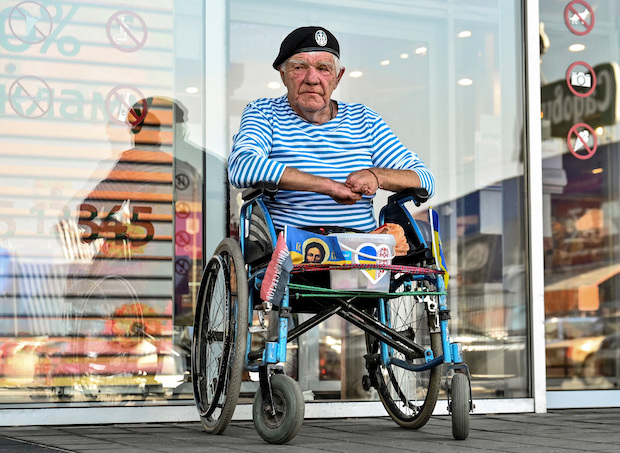
Hryhorii Yanchenko, a Soviet army veteran who fled to Zaporizhzhia from Russian controlled Kherson city, collects donations for the Ukrainian Armed Forces, amid Russia’s attack on Ukraine, in Zaporizhzhia, Ukraine Sept. 29, 2022. (REUTERS/Stringer)
ZAPORIZHZHIA, Ukraine — More than half a century after gangrene claimed his legs up to his hips and all of his fingers, Hryhoriy Yanchenko joined the Ukrainian resistance to Russia’s invasion.
Now 75, he put on the blue-striped jersey and sky-blue beret of the Soviet paratroop unit in which he served and drove his electric mobility cart through the occupied southern city of Kherson collecting donations.
He said that, with a speaker at his side playing Ukraine’s national anthem, he collected more than 600,000 hryvnias ($16,400) over six months before fleeing in September to the Ukrainian-controlled city of Zaporizhzhia.
The cash — including some inadvertently donated by Russian soldiers — has been used by a Ukrainian group to buy sniper scopes, rifle accessories, clothing and vehicles to ferry Ukrainian troops to frontlines, he said.
“Sometimes I would meet orcs (Russians) who would actually put money in my pail,” he said, a smirk deepening the wrinkles around his eyes. “Maybe it was because I am handicapped.”
“I would start (each morning) on my street,” Yanchenko told Reuters at the office of the Zaporizhzhia aid group that has cared for him since he fled Kherson. “You go out, but you don’t know if you are returning home.”
Yanchenko, who served in the Soviet airborne forces from 1966-1969, has been trying to support Ukrainian soldiers since Russia-backed separatists seized parts of east Ukraine in 2014.
First, he and friends organized a benefit concert. Then they began collecting food, clothing, and other supplies.
Galena Goncharenko, a founder of the Soldiers Shelter aid group in Zaporizhzhia who has cooperated with Yanchenko since 2015, said he had called her in March to ask if he could send her the donations from Kherson.
Despite the risks, Yanchenko also joined street protests against the Russian occupation, some of which were dispersed with warning shots.
On Ukraine’s Independence Day on Aug. 24, he went out with a Ukrainian flag in his cart’s basket and wearing a black vyshyvanka — an embroidered Ukrainian shirt worn as a talisman against evil.
Flight to safety
When Yanchenko went home, neighbors told him he was being tailed, and he decided it was time to flee Kherson, his home for 57 years, when an officer of Russia’s FSB internal security service confronted him and a friend on the street.
“He said, ‘Grandpa, you’re rolling for your last days’,” Yanchenko recalled.
His friend hid him for three days before driving him and his wheelchair to Kherson’s docks for a pre-dawn crossing of the Dnieper River.
“He put me on a boat,” Yanchenko said. “On the other side… they quickly put me in the minivan.”
Children also evacuated from Kherson clustered around him in the back until the van reached the last Russian checkpoint before Ukrainian-controlled territory.
A Russian soldier found a problem with the driver’s documents and with a red marker wrote “Back home” on the windscreen.
“This is where I felt everything collapse because if I went home, that’s it. I was gone. They were going to arrest me,” Yanchenko said.
But the driver persuaded another Russian soldier to let the vehicle through, and Yanchenko, whose wife of 51 years died in 2020, now sits in his wheelchair outside a Zaporizhzhia mall, a portable speaker playing patriotic songs as he collects more donations.
Still dressed in a Soviet paratrooper jersey, he has no plans to hang up his money pail.
“I cannot punish them myself. I don’t have that possibility. But I want to do something,” he said.
($1 = 36.5686 hryvnias)
RELATED STORIES
Half of mobilized men in Russian region sent home, commissar fired–governor
Ukraine reclaims full control from Russia of logistics hub, asserts further gains
U.S. issues new Russia sanctions for annexations in Ukraine; targets firms, lawmakers